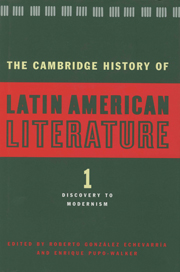Book contents
- Frontmatter
- Introduction to Volume 1
- 1 A brief history of the history of Spanish American Literature
- 2 Cultures in contact: Mesoamerica, the Andes, and the European written tradition
- 3 The first fifty years of Hispanic New World historiography: the Caribbean, Mexico, and Central America
- 4 Historians of the conquest and colonization of the New World: 1550–1620
- 5 Historians of the colonial period: 1620–1700
- 6 Colonial lyric
- 7 Epic poetry
- 8 Spanish American theatre of the colonial period
- 9 Viceregal culture
- 10 The eighteenth century: narrative forms, scholarship, and learning
- 11 Lyric poetry of the eighteenth and nineteenth centuries
- 12 Spanish American theatre of the eighteenth century
- 13 The nineteenth-century Spanish American novel
- 14 The brief narrative in Spanish America: 1835–1915
- 15 The Spanish American theatre of the nineteenth century
- 16 The essay in Spanish South America: 1800 to Modernismo
- 17 The essay of nineteenth-century Mexico, Central America, and the Caribbean
- 18 The gaucho genre
- Index
- Bibliographies
- References
2 - Cultures in contact: Mesoamerica, the Andes, and the European written tradition
Published online by Cambridge University Press: 28 March 2008
- Frontmatter
- Introduction to Volume 1
- 1 A brief history of the history of Spanish American Literature
- 2 Cultures in contact: Mesoamerica, the Andes, and the European written tradition
- 3 The first fifty years of Hispanic New World historiography: the Caribbean, Mexico, and Central America
- 4 Historians of the conquest and colonization of the New World: 1550–1620
- 5 Historians of the colonial period: 1620–1700
- 6 Colonial lyric
- 7 Epic poetry
- 8 Spanish American theatre of the colonial period
- 9 Viceregal culture
- 10 The eighteenth century: narrative forms, scholarship, and learning
- 11 Lyric poetry of the eighteenth and nineteenth centuries
- 12 Spanish American theatre of the eighteenth century
- 13 The nineteenth-century Spanish American novel
- 14 The brief narrative in Spanish America: 1835–1915
- 15 The Spanish American theatre of the nineteenth century
- 16 The essay in Spanish South America: 1800 to Modernismo
- 17 The essay of nineteenth-century Mexico, Central America, and the Caribbean
- 18 The gaucho genre
- Index
- Bibliographies
- References
Summary
The range of texts and traditions to be considered here corresponds ultimately to the interpretive responses made by native American cultures to life under colonialism. Without colonialism from Europe, there would not exist this corpus of cultural productions, “written down” in alphabetic script in various languages. Without the inclusion of native American voices and related subject positions (such as those taken by mestizo writers), there can be no full history of colonial Spanish American culture as manifest in the spoken and written word. “Cultures in contact” is thus the point of departure from which we begin this essay on indigenous American cultural expression after 1492.
Introduction: Cultures in contact
But, we,
what now, immediately, will we say?
Supposing that we, we are those who
shelter the people,
we are mothers to the people, we are
fathers to the people,
perchance, then, are we, here before you,
to destroy it, the ancient law;
the one which was greatly esteemed
by our grandparents, our women;
the one which they would go speaking of
favorably,
the one which they would go admiring,
the lords, the speakers?
(Klor de Alva, “The Aztec-Spanish dialogues [1524],” 107-8)
These words represent one of the earliest examples of the cultural traditions to be considered here. Like most of those to be studied, this passage reconstructs an earlier formulation. Set down in 1564 by Fray Bernardino de Sahagún and his four Nahua collaborators, Antonio Valeriano, Antonio Vegerano, Martín Iacobita, and Andrés Leonardo, these words recalled a dialogue which was to have taken place in 1524 between the first twelve Franciscan friars in New Spain and the elders and priests of the Mexica (Aztec) people.
- Type
- Chapter
- Information
- The Cambridge History of Latin American Literature , pp. 33 - 57Publisher: Cambridge University PressPrint publication year: 1996
References
- 4
- Cited by



